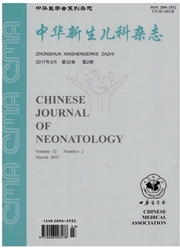

 中文摘要:
中文摘要:
目的 探讨早期早产儿和晚期早产儿合并早发型败血症时的免疫功能特点。方法选择2012年6月至2015年3月广西妇幼保健院新生儿科收治的新生儿,出生24 h内采血进行血常规及免疫功能检查,根据胎龄和感染情况分为早期早产儿败血症组和无感染组、晚期早产儿败血症组和无感染组、足月儿败血症组和无感染组共6组,无感染组按患儿入院先后顺序各纳入100例。检测项目包括血淋巴细胞亚群CD3+、CD4+、CD8+、CD4+/CD8+、CD19+和NK,以及血清Ig G、Ig A、Ig M含量。结果 早期早产儿败血症组NK细胞比例高于无感染组,差异有统计学意义(P〈0.05);晚期早产儿败血症组CD3+、CD4+、CD19+淋巴细胞比例低于无感染组,NK细胞比例高于无感染组,差异有统计学意义(P〈0.05);足月儿败血症组CD3+、CD4+淋巴细胞比例低于无感染组,NK细胞比例高于无感染组,差异有统计学意义(P〈0.05)。在合并早发型败血症的不同胎龄新生儿中,早期早产儿CD4+低于晚期早产儿,早期早产儿和晚期早产儿CD3+、CD4+、CD8+、CD19+、NK均低于足月儿,差异有统计学意义(P〈0.05);早期早产儿和晚期早产儿Ig G、Ig M低于足月儿。结论 早期早产儿和晚期早产儿的适应性免疫和固有免疫特点相似,且在感染时,晚期早产儿免疫功能并不明显优于早期早产儿。
 英文摘要:
英文摘要:
Objective early-onset sepsis. Methods To study the immune function of Neonates were assigned into 6 groups early- and late-preterm infants with according to their gestational age and infection : early-preterm + sepsis group ( E + S ), non-infected early-preterm group ( E ), late-preterm + sepsis group( L + S) and non-infected late-preterm group ( L), term infants + sepsis group ( T + S ) and non-infected term infants group (T). The number of non-infected infants was 100 in each group (E, L,T group). Blood samples were collected within 24 hours after birth and the venous lymphocyte subpopulation (CD3+ T%, CD4+ T%, CD8+ T%, CIM+/CD8+, CD19+% and NK%)and the immunoglobins( IgG, IgA, IgM) were detected. Results The NK% of E + S group was significantly higher than E group(P 〈0. 05). The CD3 + T% , CD4 + T% , CD19 + % of L + S group was lower than L group, and the NK% of L + S group was higher than L group (P 〈 0. 05). The CD3 + T% , CIM + T% of T + S group was lower than T group, and the NK% of T + S group was higher than L group ( P 〈 0.05 ). The CD4 + T% in E +roun was lnwer than T ( P t t/ n+; + TK+ cr+ + To1+CD19 +% and NK% of the two preterm groups (E and T groups) were lower than the term infants group (P 〈 0.05). IgG and IgM of E + S group and L + S group were lower than T + S group. Conclusions The early- and late- preterm neonates have similar adaptive and innate immune function. The immune function of late-preterm infants is no better than early-preterm infants during infection.
 同期刊论文项目
同期刊论文项目
 同项目期刊论文
同项目期刊论文
 期刊信息
期刊信息
